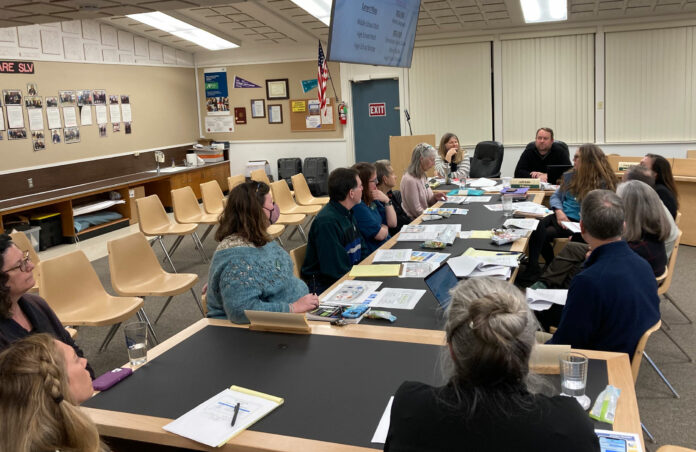
Just 26 miles away as the crow flies, enrollment has dropped 76% at the Ravenswood City School District in East Palo Alto; but here in the Santa Cruz Mountains, the San Lorenzo Valley Unified School District has seen a much more modest decline.
Nevertheless, trustees here have been sharpening their pencils, as they seek to deal with a corresponding drop in government funding, including at a Feb. 1 workshop that followed the regularly scheduled board meeting.
“We’re going to share with you how revenue comes into SLV, and our main expenses,” said Christopher Schiermeyer, SLVUSD’s superintendent. “A budget is very complicated, and there are a lot of components to it.”
He reminded trustees of the main buckets of government money the District relies on, including “Local Control Funding Formula” cash—its main source of financial stability, money it gets based on its level of free lunch and English-learner students, and money related to property tax revenue.
Julie McCarthy, SLVUSD’s assistant superintendent business services, said “due to student illnesses,” the attendance rate had dropped to 89%, from 91%—where she hopes it will return to by 2023-24.
Families continue to move children out of the public school and into charter school programs, she added.
Schiermeyer said while Gov. Gavin Newsom talks about spending $24,000 per student in this year’s State projections, that’s an average. SLVUSD only gets around $13,000 per student.
The District relies on money calculated based on property values in the area. That means planners have to expect major fluctuations, such as when the 2008 recession hit.
SLVUSD Chief HR Officer Andrew Lucia said staff have remained loyal to the District in the wake of administrators choosing to keep staff on during the pandemic instead of focusing on cutting costs. Employees are one the biggest expenses for the District, he said, noting it paid out $17,821,239 in salaries and benefits in 2018-19.
“During Covid, instead of releasing staff, we repurposed staff,” he said. “We kind of just held the line.”
Administrators made a conscious decision not to hand out pink slips, even as it lost 200 students due to a variety of factors.
“As you can tell, we’ve had a decrease in student enrollment, but at the time we’ve maintained our FTE (employment) levels,” he said. “That’s surrounding kids with more adults on a daily basis to help them be better students.”
Assistant Superintendent-Instructional Services Jennifer McRae said the District spends $300,000 per year on classroom materials. And, whenever it introduces or updates courses, that can be quite expensive—but is well worth the cost, she continued.
“It’s a fairly intense process,” she said, “going from ‘We need curriculum’ to ‘We have something to implement.’”
For example, right now, they’re working on refreshing the middle and high schools’ math curriculum, as well as high school biology lessons.
“The really fun part is we have a whole bunch of options that we look at,” she said. “They score them on the rubrics…That takes a couple days.”
SLVUSD spent $10,000 on middle school math lesson plans and training materials and $30,000 for the high school math components.
“We are serving the families,” she said, reminding the trustees it will be up to them whether they move forward with adopting the curriculum they’re testing. “It is where we should spend our money.”
Jeff Kitts, the district’s IT director, said technology is becoming an increasingly significant part of education, noting there are probably 200 miles of cable connecting SLVUSD sites.
The District spends $42,550 per year on data lines, $25,000 per year on network licenses and $36,000 per year for lock screens so students can’t play games or misbehave digitally while in class on laptops provided by the school system.
After all, the District spends $100,000 per year for Chromebooks (and has spent $897,628 to purchase 2,589 in the last five years).
“You can’t control somebody’s desktop if it’s their personal device,” he said. “Chromebooks fit the bill better than anything else.”
Eventually, the District would like to see all learners in Grades 3-12 to have one.
Board Clerk Stacy Newsom Kerr wondered what the District does with all the eventual e-waste.
“Is there a plan to recycle or dispose of Chromebooks that have reached their destiny?” she asked.
Kitts said some computers, after they’re no longer supported, are pretty banged up.
“We want to responsibly recycle them,” he said. “We just don’t want them shipped to Vietnam and have kids get poisoned taking the metals out.”
That can mean giving the old Chromebooks away for free to a company that gets money from the government to dismantle them responsibly, he explained.
Jennifer Lahey, assistant superintendent of special education, said the total number of students in the program jumped from 277 in 2018-19 to 281 in 2022-23.
Her team includes a program specialist, three psychologists, four speech and language therapists, occupational therapists, an adaptive physical education teacher and 17 District-hired instructional aides. That’s on top of contracts with Easterseals and Balance for Kids, who also provide instructional aides.
It’s not that there isn’t support from government flowing for special ed at SLVUSD, she added.
“We’re getting more money,” said Lahey, referring to a chart on the TV screen overhead. “But the red part shows we’re spending more money to support our students’ needs.”
SLVUSD paid $4,550,318 for special ed in 2018-19, which rose to $6,302,617 for 2022-23, in part due to demand during successive waves of the mutating coronavirus.
“We did see a higher level of requests for assessment,” she said, adding the higher level of support was needed, “—after all of the trauma, Covid and all that.”
In the last few years a lot of “high need” students moved into the region covered by the District’s boundaries, Schiermeyer said.
“It’s just what it is,” he said. “It’s the student population.”
Chief Business Officer Julie McCarthy said despite having just half the bus drivers it’s supposed to (four instead of eight), the District’s been able to restore service with the help of its partners—including a “pretty devoted crew” of substitute drivers.
“They all do a wonderful job,” she said. “Can’t say enough about them.”
In the 2022-23 budget, it cost $398,338 for special ed transportation and $805,106 for regular home-to-school trips. That was a huge jump from 2021-22’s $308,725 for special ed and $478,470 for home-to-school.
But, actually, it’s not too much more than 2018-19’s overall cost of $1,037,443. Plus, the District is expecting to receive more than $200,000 in government funds to cover some transportation expenses.













This stat doesn’t seem like a “jump,” but rather a slight increase:
Jennifer Lahey, assistant superintendent of special education, said the total number of students in the program jumped from 277 in 2018-19 to 281 in 2022-23.
But overall, excellent piece!